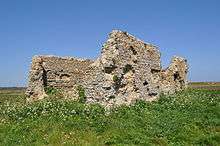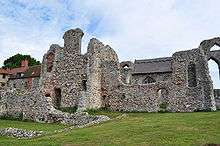Leiston Abbey

Leiston Abbey, in Suffolk, England, was formerly known as St Mary's Abbey. It was founded in 1182 at Minsmere by Ranulf de Glanville, Lord Chief Justice to Henry II. The only remains of the old site are the ruins of the Abbey chapel.[1]
In 1363 the Abbey was transferred to Leiston, and its patron, Robert de Ufford, 1st Earl of Suffolk, devoted his last years to the building. The ruins are also the inspiration for the musical composition Ruins of Leiston, written in 2012 by Kurt Rampton.
Leiston Abbey ruins
The order of the Abbey was a House of Augustinian Canons Regular who followed the Premonstratensian rule. Unlike monks, their main duties were preaching and pastoral work.
Leiston Abbey grounds

Following the Dissolution of the Monasteries in 1536, Leiston Abbey was granted to Charles Brandon, 3rd Duke of Suffolk and brother-in-law to Henry VIII. The Abbey became a farm, the farmhouse being built into the ruins. Later, a Georgian front was added to the house, which was extended in the 1920s.
In 1928 the Abbey ruins and farm were bought by Ellen Wrightson for use as a religious retreat. When she died in 1946, she bequeathed the house, ruins, land and buildings to the Diocese of St Edmundsbury and Ipswich. It was purchased in 1977 by the Pro Corda Trust and is managed by the Pro Corda Music School. It is in the guardianship of English Heritage.
Archaeological Investigations
Leiston Abbey was the first crowdfunding campaign to run on the DigVentures DigStarter platform in 2013. The project is ongoing and in 2015 is entering the third year of five proposed digging seasons under a licence granted by English Heritage. Its aim has been to breathe new life into Leiston Abbey, providing opportunities for visitors to join in with the excavation, and to integrate the heritage attraction with the artistic and musical life of the onsite music school, Pro Corda, who manage the site for English Heritage. Fieldwork has so far focused on characterising undefined earthworks and settlement evidence in three different areas of the site, with a programme of remote sensing used to target thirteen small-scale excavation trenches aiming to identify settlement evidence indicated by geophysical anomalies or extant earthworks. Additional work has included a photogrammetry survey to produce a metrically accurate 3D digital elevation model of the Abbey Church, and a low-level aerial photography survey using kite mounted cameras and UAVs (drones) to assess structural evidence for absent buildings associated with the eastern range.
References
- ↑ New life for old chapel, Ipswich Evening Star, 4 July 2008
External links
| Wikimedia Commons has media related to Leiston Abbey. |
Coordinates: 52°13′17″N 1°34′39″E / 52.2214°N 1.5776°E